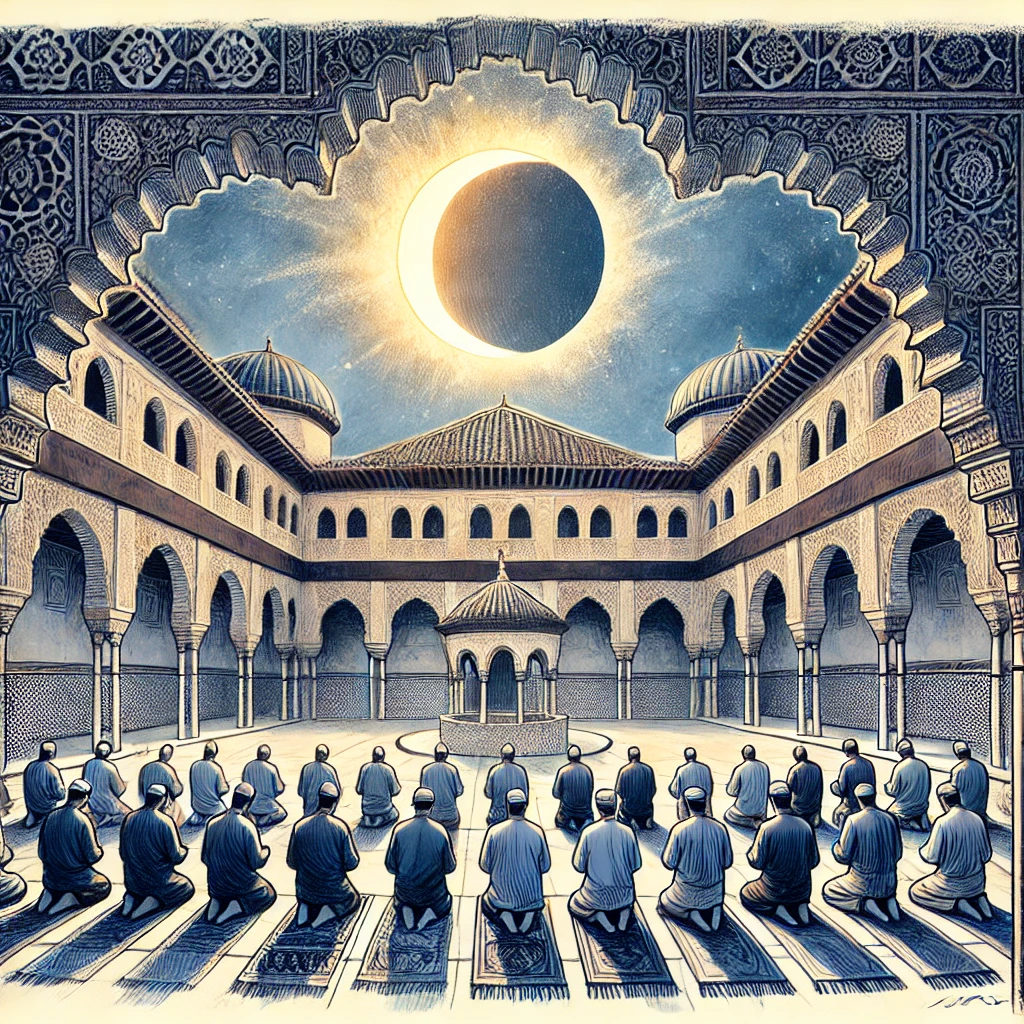﷽
Question: What is the ruling on the eclipse prayer in the Maliki school, and how does one pray it?
Here is a guide to the solar eclipse prayer in the Maliki school. It is adopted from Mukhtasar Khalil and its various commentaries and supplementary sources. The solar eclipse is from one of the signs of Allah and should be a reminder of Allah’s power over all things, and the ease with which He can take away our blessings- even the sun itself. It should not be associated with superstitions and other misguidance, as the Prophet ﷺ himself reminded us.
The Prophet ﷺ said, “The sun and the moon do not eclipse because of the death of someone from the people but they are two signs from the signs of Allah. When you see them, then stand up and pray.”
Its Ruling
It has the same ruling as Eid Prayer, i.e it is a highly emphasized Sunnah (Sunnah Mu’akada).
Its Timing
It is a prayer prayed only between ishraq (when the sun has risen above the height of a spear (around 2-30 minutes after sunrise) and nafl prayers are permissible to pray again) until zawal (when Dhuhr prayer starts). So, if the eclipse occurs after Dhuhr, then there is no prayer for it.
The ruling on the timing is based on a direct, explicit statement from the Mudawana by Ibn Al-Qasim, the greatest student of Imam Malik, which is the most authoritative primary source of the school. This is the mashhur position. However, Imam Al-Dasuqi mentions that there are three positions in the school on the timing of the prayer:
- It is only prayed between ishraq and Zawal (the start of Dhuhr). This is the prominent position of the school (mashhur) and is based on the direct statement of the Mudawwana. (See Khalil, Dusuqi, Hattab, Mawwaq, and others).
- It is from the rising of the sun until its setting- i.e all day. This is the opinion of Al-Lakhmi and some others.
- It is from the rising of the sun until Asr time.
How Is It Prayed?
It is two rak’ahs that are done quietly. For every rak’a there are two ruku’s and two standings. In other words, the person would start the prayer and recite as normally and then go into ruku’. After they rise from the ruku’, they would do another recitation of Al-Fatiha and a sura, before going into ruku’ for a second time. Then, when they rise, they would go into sujud, after which they would repeat the same thing for the second rak’a.
Its Recommendations
The following are recommendations for how it should be prayed:
- In the Masjid
- In the first recitation (Rak’a 1, standing 1), one should recite Al-Baqara. In the second recitation (Rak’a 1, standing 2), they recite Aal-Imran. In the third recitation (Rak’a 2, standing 1), they recite Al-Nisa. In the fourth recitation (Rak’a 2, standing 2), they recite Al-Maidah.
- The Imam gives a speech afterwards. This speech is not a Khutba, but it should be a reminder about something like the Power of Allah, or dispelling superstitions about solar eclipses and reminding people to fear Allah.
- The time in each ruku’ should be almost as long as the recitation.
- The time in each sujud should be almost as long as the ruku’. The sitting between the two sajdas is done as normal.
Some Possible Scenarios
If one catches the second ruku’ of the Rak’a, then they have caught that entire rak’a. So if one joined the prayer at Rak’a 1, ruku’ 2, then they would not need to make up another rak’a after the Imam exits the prayer. If they joined the prayer at Rak’a 2, ruku’ 2, they would need to make up one rak’a by themselves after the Imam finishes the prayer.
If one finishes the prayer before the eclipse ends, they do not repeat the prayer again.
If the eclipse ends while one has already completed one rak’a (finished the two sujud of the first rak’a), then they should continue with the prayer. There are two opinions, equally strong about how they complete the rest of the prayer. The opinion of Imam Sahnun (the student of Ibn Al-Qasim) was that they should finish the prayer like a regular nafl- no elongation or extra standing and ruku’. The other opinion is of Asbagh, (the classmate of Ibn Al-Qasim and another senior student of Imam Malik) was of the opinion that they should complete the prayer with the extra standing and ruku’ but do it quickly without elongation.
If the eclipse ends and one has not completed the entire first rak’ah, then they must complete the prayer as a regular nafl prayer, with no extra ruku’ or standings.
SInce the first recitation and ruku’ is a Sunna, and the second recitation and ruku’ for each rak’a is the integral (fard) for the prayer, if one misses either the first recitation or ruku’ for a rak’a (i.e they go directly into sujud after doing only 1 standing and ruku’), then they should do a prostration of forgetfulness (sujud sahw) before they say the salam (i.e a qabli).
The Lunar Eclipse
It is recommended to pray nawafil during the lunar eclipse at night, but it is not an emphasized sunna like the solar eclipse. It is done out loud, in the home, and one does normal units of nafl prayers- 2 rak’as at a time. They continue this until the eclipse ends. So they would do two units, then look outside to see if the eclipse is ongoing. If it is, then they would do two more rak’as, and so on.
And Allah knows best.
Written by Uthman Qureshi
References:
Hashiyat Al-Dasuqi by Muhammad ibn Arafa Al-Dasuqi
Mawahib al-Jalil by Al-Hattab
Al-Taj wal Iklil by Al-Mawwaq
Kifayat Al-Talib Al-Rabbani by Abu Hassan Ali Al-Manufi Al-Shadhili
Qaribat ul-Salik by Ali Al-Amrusi
